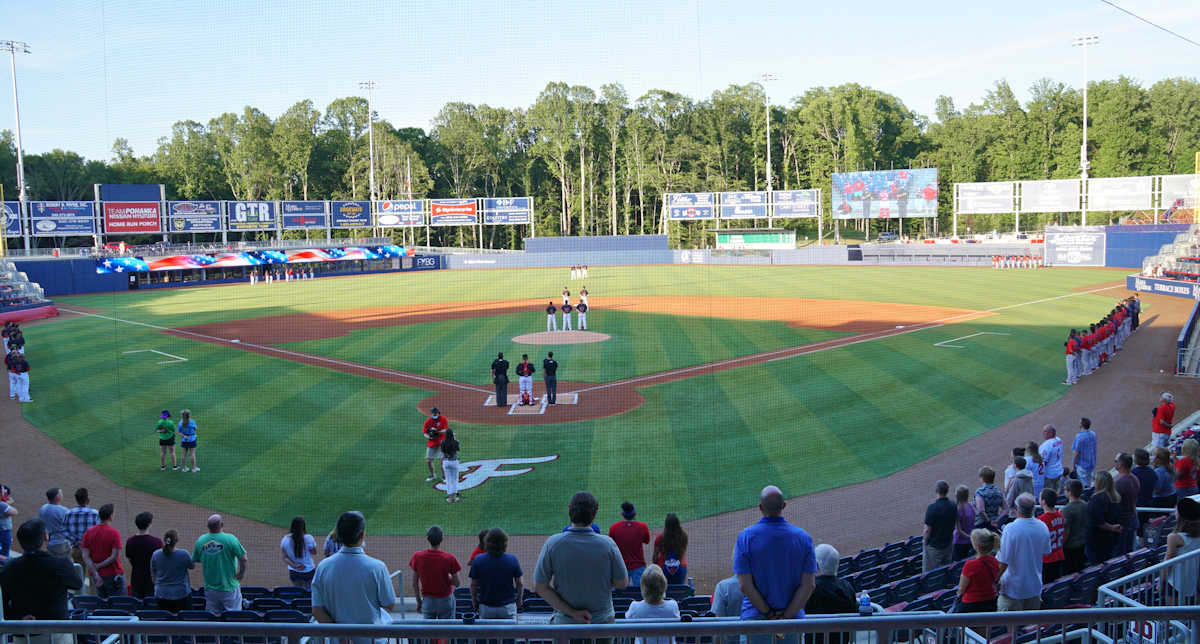
Article and photos by Joe Mock, BaseballParks.com
All rights reserved
FREDERICKSBURG, Virginia True fans really respect an impressive collection of baseball memorabilia. Whether it’s baseball cards, old scorecards, autographed books, game-used jerseys, fans eat this up.
| Ballpark Stats |
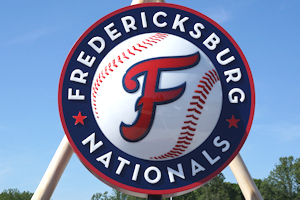 |
| Team: Fredericksburg Nationals of the Low-A East League |
| First game: May 11, 2021, a 7-5 loss to Delmarva |
| Capacity: 6,000, of which 4,000 are permanent seats |
| Dimensions: LF – 326; LCF – 370; CF – 402; RCF – 360; RF – 327 |
| Architects: Trish England, Design Architect; Tetra Tech, Architect of Record |
| Construction: L.F. Jennings and Henderson Construction |
| Price: $35 million for land lease and construction |
| Home dugout: 3B side |
| Field points: northeast |
| Playing surface: artificial surface by Shaw Sports Turf |
| Naming rights: One is forthcoming |
| Ticket info: milb.com/fredericksburg/tickets/ |
| Betcha didn’t know: The artificial turf here is the first in the Minors to use organic infill |
Isn’t that why millions have flocked to Cooperstown?
Well, if you want to see the most impressive collection of autographed baseballs ever, come to Fredericksburg, Virginia.
Oh, and there is a very nice ballpark surrounding that collection.
“The first baseball I ever had signed was outside of Ebbets Field when I was a kid,” says 81-year-old Art Silber, principal owner of the Fredericksburg Nationals – or “FredNats” for short. “I gave Jackie Robinson a ball and he took it into the park and he had all of the players sign it. He gave it back to me the next day.” The fact that Robinson obtained the other signatures for Silber made that ball all the more valuable, since he “was a symbol for immigrant communities overcoming discrimination and difficulties.”
Silber says that his collection of autographed baseballs grew tremendously over the decades. Working in the sport, he had the opportunity to obtain many signatures himself. He also purchased signed balls from individual collectors and estate sales, “but never from an auction house,” he says with pride.
In all, he owns 900 signed balls, 570 of which are now on display in the Club at the heart of FredNats Ballpark. “Even the cabinetry was in my home and we moved it to the park.” The plan is to rotate the balls, moving several hundred back to Silber’s home while bringing in many of the 330 that didn’t make the initial cut to be on display.
You could easily spend nine innings just marveling at the signatures on those baseballs. But you won’t want to, because there’s an attractive, functional ballpark to explore outside the doors of the Club.
Admittedly, it’s a park with a simple placeholder name — FredNats Ballpark – although a corporate sponsorship name will be implemented soon. “Right now, we have a number of companies lined up, wanting to discuss this with us,” says Silber.
The most fascinating discussions, though, have already occurred. They involved the mind-twisting processes of finding exactly where to locate a new park and how to pay for it. We’ll tackle the location conundrum in the next section, but let’s examine the financials now. If you get a little lost on the details, welcome to the club!
When Silber was a relatively young man (age 55), he retired as President/CEO of a medium-size bank. Needless to say, his understanding of financial matters is exceptional. That’s the only way this scenario could’ve been dreamed up. It also helped that Silber knew what terms *didn’t* make sense, because he’d turned down some stinky ones in Northern Virginia.
| “Unique in baseball” |
 |
| Principal owner of the FredNats, Art Silber (left), is shown with Murray Cook of BrightView, field consultant for MLB. This was taken while the ballpark was still under construction. Peter Kirk says that Silber’s family “is unique in baseball.” Photo courtesy of Murray Cook |
He explained that the city government of Fredericksburg “was too small to do the bonds to build the stadium, so we had to get creative.” He utilized the expertise of Wall Street-firm UBS to guide the unusual approach.
Essentially, three companies were formed: Fredericksburg Baseball (Silber and his two children — son Seth is the Treasurer and daughter Lani Weiss is team President) owns the franchise; SAJ Baseball owns the ballpark; SAJ Entertainment owns the lease on the Expo Center across the street. SAJ Baseball pays Fredericksburg Baseball to play or “perform,” like a theater would pay a group of actors to put on a show. Consequently, all ticket sales, concession revenues and sponsorships were contracted with SAJ Baseball.
There were two bonds issued, totaling about $40 million, to fund construction. The debt service on the bonds is about $2.8 million. Silber says the city helps fund about $1 million a year, which they can afford to do because of the taxes they are collecting from all of the baseball activity. The other $1.8 million is funded through the revenue that SAJ Baseball collects.
“It was a very creative financing that we put together,” Peter Kirk, a former Minor League team owner and modern-day ballpark-planning savant, told us. Kirk was brought in to plan a stadium that would cost less than $40 million.
“The Silber family is unique in baseball,” Kirk added. “They have owned the team for 30 years and now own both the team and the stadium. They are the only owners that I know of that own the ballpark and paid to construct it. There are no other partners in the ownership and no public money in the stadium.
“This allowed creativity, cost savings and speed that I never experienced in the 15 other ballparks on which I have worked,” Kirk says.
It helps that “when you build a park yourself, you can do it for 80-90% of what it would cost if a government paid for it,” adds Silber.
“At $35 million for the land lease and construction, it’s a lot of ballpark,” observed Nick Hall, Exec VP and GM of the FredNats. Truer words were never spoken, especially considering the cost of the new parks in Kannapolis, Wichita and Worcester. Further, the land is leased for 50 years. This shows the Silber family’s “commitment to Fredericksburg,” says Kirk. “The best indication of the commitment, however, is that Lani and her family moved to Fredericksburg before the City gave its approval.”
When everyone thought there would be a 2020 season, the team was scrambling to get the park done by April of last year. “The ballpark was only going to be 60% done if it would’ve opened April of 2020,” said Hall. “Don’t get me wrong, we would’ve preferred to have opened at 60% and played the 2020 season than waiting until now, but the year delay helped us to get things ready.”
Opening day for FredNats Ballpark on May 11, 2021 was a joyous event indeed for the Silber family — complete with a surprise from Kirk (see below).
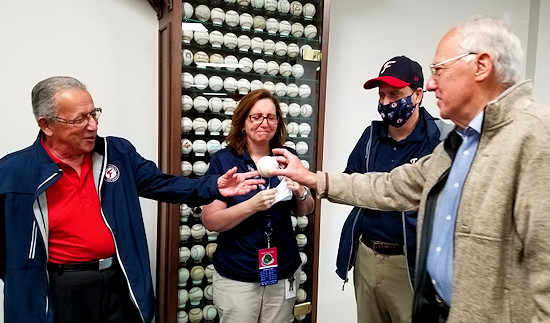 |
| Peter Kirk (far right) pulled off quite a surprise for the Silber family (Art Silber on far left, Lani Weiss and Seth Silber wearing the face mask) on Opening Night of FredNats Ballpark. Kirk said he secretly had “both managers and the umpire agree to have the first hitter take the first pitch and the catcher roll the ball to the home dugout. The ball was slipped to me and I kept it hidden until I could get the Silbers together.” Kirk then surprised the family that owns the team with the ball. They were standing in front of Art’s collection of signed baseballs. Photo courtesy of Peter Kirk |
Between COVID and sharp cost increases in construction materials, not all amenities were 100% completed, but games could easily be played. What is the location like, and how did the park-built-on-a-budget turn out? Read on for our review.
The Setting
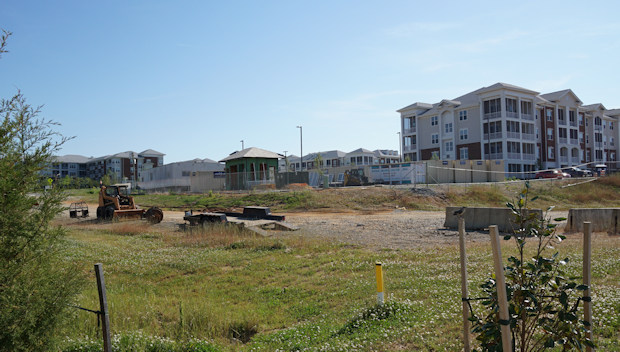
Silber was still a bank president – dealing often with the financing of Minor League projects – when he received a call asking if any of the bank’s customers would be interested in purchasing the franchise. Kirk (“one of my closest friends,” says Silber) suggested to Silber that he buy the franchise. Since he loved baseball, he agreed.
I don’t want to belabor the point (just like it’s not proper to speak ill of the dead), but the team’s former ballpark was truly horrible. Plus its location was just as horrible. “I bought the club 31 years ago,” says Silber. “When I saw the park for the first time, my immediate thought was ‘My God, we need a new ballpark.’”
| Erector set |
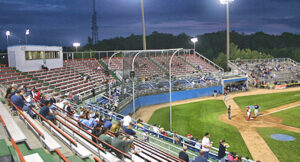 |
| When your ballpark is called an “erector set,” it’s not a compliment. Pfitzner Stadium in Woodbridge was aluminum upon aluminum. It was an awful look. “My God, we need a new ballpark,” Silber exclaimed upon seeing it for the first time. |
Pfitzner Stadium was often likened to an erector set, since it was layer upon layer of aluminum, with aluminum benches everywhere. You couldn’t see the field from the concession stands or tiny merchandise shop. Worse yet was the fact that it was nowhere near any highway, so the drive to get to the county complex was endless, plus you had to walk past recreation ballfields to get to its gates.
Adding to the problems was that the location was linked to a county name rather than a city. In fact, the ballpark was called Prince William County Stadium for ten seasons (and Pfitzner Stadium after that), and the team used Prince William as its geographic identifier for 15 years before switching to “Potomac” in 1999. Even then, it didn’t provide much in the way of a community identity. A byproduct of that was a lack of merchandise sales.
So Silber wanted to move his team. You might think it’s a simple matter for a team to find a place to build a new ballpark, especially when the franchise is willing to fund most or all of the construction costs. Note that Silber owned the team for three decades before they moved into the replacement for Pfitzner.
So, no, it’s not that easy.
They examined land adjacent to their old home – after all, the county already owned it – but at the end of the day, why remain in a lousy location? A number of spots much closer to the main I-95 artery through Northern Virginia were proposed. Naysayers always said it would make traffic worse, but would a couple of thousand cars heading to a game at 6:00 or 6:30 really make any difference on a commuter thoroughfare that routinely carries tens of thousands of vehicles a day?
| What might’ve been |
 |
| While this looks like a photo, it’s actually a rendering from 2012 of what a new park would’ve looked like right next to an interchange of I-95. Rendering courtesy of FredNats and AECOM |
“I can’t even count the number of sites in Northern Virginia where it looked like, OK, here’s where we’re going to build,” said Trish England, who eventually designed the FredNats Ballparkinally, it looked like the perfect spot was identified in Woodbridge, just off an interchange of 95 close to the sprawling Potomac Mills shopping district. A rendering of what it would’ve looked like is shown in the adjacent box.
Negotiations dragged on for a couple of years, all the while the team was languishing in its erector-set home six miles away as the crow flies, but that six miles could easily take a half hour to drive.
“It was a great location,” Silber said. “But it became a monster political issue. We were willing to pay for the park, and (Prince William) county would’ve had to pay a couple of million on access and for a commuter parking garage that was badly needed. The county wanted us to do financial guarantees that would’ve imperiled our ability to operate the team.
“When we walked away from that deal in Prince William, it made a lot of press.” A lot of the sentiment in the local media was of the “no public money for rich team owners” and “no welfare for millionaires” variety. Silber also blames the Tea Party for being against public expenditures.
But one positive thing that resulted from the hubbub was that “we were contacted by cities and counties and developers, all around Northern Virginia,” Silber said. That included the economic-development people in Fredericksburg, 30 miles south of the “great location” that fell through along I-95 near Woodbridge.
Kirk and Silber agreed to attend a meeting in Fredericksburg — which had struck out in an attempt to bring the Hagerstown Suns to the city in 2013 — and “to our surprise, they had a lot of major business leaders there,” recalls Silber. “They let us know they really wanted us.”
While all signs pointed to Fredericksburg being the best destination for the team, there was no consensus on exactly where in Fredericksburg the park should be built. Silber and a major developer in the area, Larry Silver (not to be confused with Art Silber), utilize the same attorney, so a conference call was arranged.
Silver was pretty far along developing an area on the west side of I-95 called Central Park. An undeveloped 23-acre parcel of that land had promise. The bad news was that it sloped down steeply to the Rappahannock River. The good news was that it wrapped around and actually touched I-95.
| Female empowerment |
| It’s impossible to look at the team of professionals behind FredNats Ballpark and not be impressed by the number of women involved. Art Silber’s daughter Lani Weiss has been team president for 22 years, and as you know, pro baseball is a male-dominated enterprise. So, too, is sports architecture, and Trish England is the design architect on the park. The Silbers also named Marlene Camp as GM of the Expo across the parking lot from the ballpark. |
Silber realized that controlling the land where a two-sided, high-tech advertising sign could be erected – “especially when cars are driving by very slowly due to the traffic,” he adds – was a potential goldmine. Imagine what a potential naming-sponsor for the ballpark would pay to have its name on this sign for thousands of commuters a day to see (much like the Chicago Dogs do along I-294 beyond the outfield of their ballpark).
A deal came together where Silber agreed to take on the operations of the Fredericksburg Expo and Conference Center in the development, and to lease the 23 acres to build the ballpark. He then worked his financial magic to create the package so construction could start in 2019.
To get to FredNats Park, you have to jump off I-95 at Exit 130 and wind around through the Central Park development for over two miles. From the developer’s point of view, that’s fantastic, because it shows off all the development has to offer to thousands of people heading to a game.
And this development is simply wonderful. There is so much here, like shopping, very nice apartment complexes (the one closest to the ballpark is shown in the photo at the top of this section — yes, things weren’t finished when the ballpark opened), a staggering 48 eating/drinking places, hotels and the expo center. It’s almost like the mixed-used development sells the ballpark rather than the ballpark being the centerpiece of a development. Yes, that’s the opposite of how these things usually work.
Admittedly, this isn’t anywhere close to the tourist areas of Fredericksburg, which are all on the east side of 95. I mean, George Washington was born here, so folks like to visit. The colonial taverns and University of Mary Washington are all on the east side.
But what about the topography of the site selected for the ballpark? “In my 30 years of doing stadiums, I would say this was the most challenging,” revealed England. “I mean, it’s typical of Virginia in its rolling land. And there was a ravine that ran right down from the center of what was going to be the field.” That happens when you’re adjacent to a river. “Oh, and there were wetlands, too.”
These were all challenges that Trish, Tetra Tech (the architects of record) and the construction team were able to overcome, and now the FredNats are playing baseball there.
So you have to drive a little ways off the Interstate to get to the site – but nothing compared to the congested distance it took to get to their previous park. Does the park’s exterior convince you that the drive was worth it? Um, no, but keep reading.
The Exterior
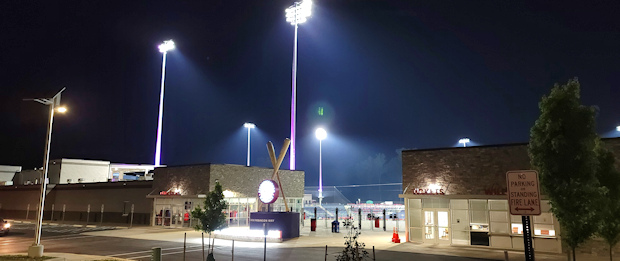
I mentioned in the review of Kannapolis’ Atrium Health Ballpark that the exterior was certainly not the strongest aspect of the architecture. That’s even more true here.
To be honest, if you’re going to build a Single-A ballpark for under $40 million – with all of the allowances that had to be made for the extremely uneven topography – you’re not going to have an elaborate exterior façade.
And FredNats Ballpark certainly doesn’t.
 If you consider the parking lot as part of the park’s exterior, then let’s start there. The lots are between the stadium and the Expo Center up the hill, because remember this land is sloping down toward the Rappahannock River (although you can’t actually see the river from within the ballpark at all due to the dense trees).
If you consider the parking lot as part of the park’s exterior, then let’s start there. The lots are between the stadium and the Expo Center up the hill, because remember this land is sloping down toward the Rappahannock River (although you can’t actually see the river from within the ballpark at all due to the dense trees).
And for a sellout crowd, the lots certainly aren’t adequate. “We know that one problem we have is there’s not enough parking,” admitted Hall.
The lots they do have are pretty much all on the first-base side of the ballpark, because there is dense forest on the other three sides.
It’s also very nice that the lots are illuminated by solar-powered lights (see photo, courtesy of Peter Kirk).
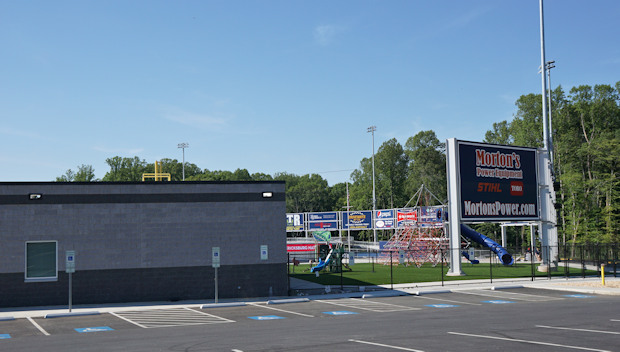
If you stand in the parking lots and look at the ballpark, from right to left you see the following: a chain-link fence surrounding the children’s play area located near the right-field foul pole (photo above); a building with two tones of gray split-face block that contains the team offices and nice walk-in ticket counters; the opening in the structures where the main entryway is located; and then lots and lots of gray cinder-block walls (below right) stretching down to the area behind home plate (which has a much smaller entry gate). There is very limited parking on the third-base side of the ballpark, which I assume is for employees and players.
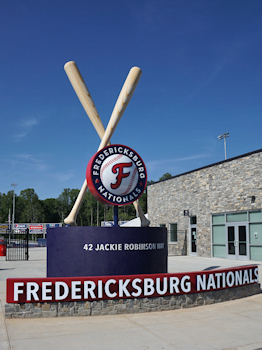 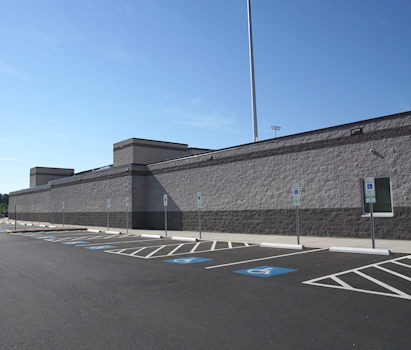 |
There is no way to see what the exterior of the outfield looks like from the outside, because there is no path between the park and the slope down to the river.
They didn’t leave the main entryway completely barren, though. There is a statue/sculpture with large crossed bats and FREDERICKSBURG NATIONALS displayed prominently – twice, in fact (above left).
And in an obvious nod to owner Art Silber who grew up near Ebbets Field, the street address is shown: 42 Jackie Robinson Way.
This piece of art is striking, and looks fantastic at night. It’s noteworthy that Art Silber’s grandson Alex designed this.
Other than this display, the entry is fairly spartan. The team intends to do more with this area at some point, though. “The entry is a work in progress,” admits England.
To say that the interior of the park completely outshines the exterior would be an understatement … so move on to page 2 to see the inside of FredNats Ballpark.